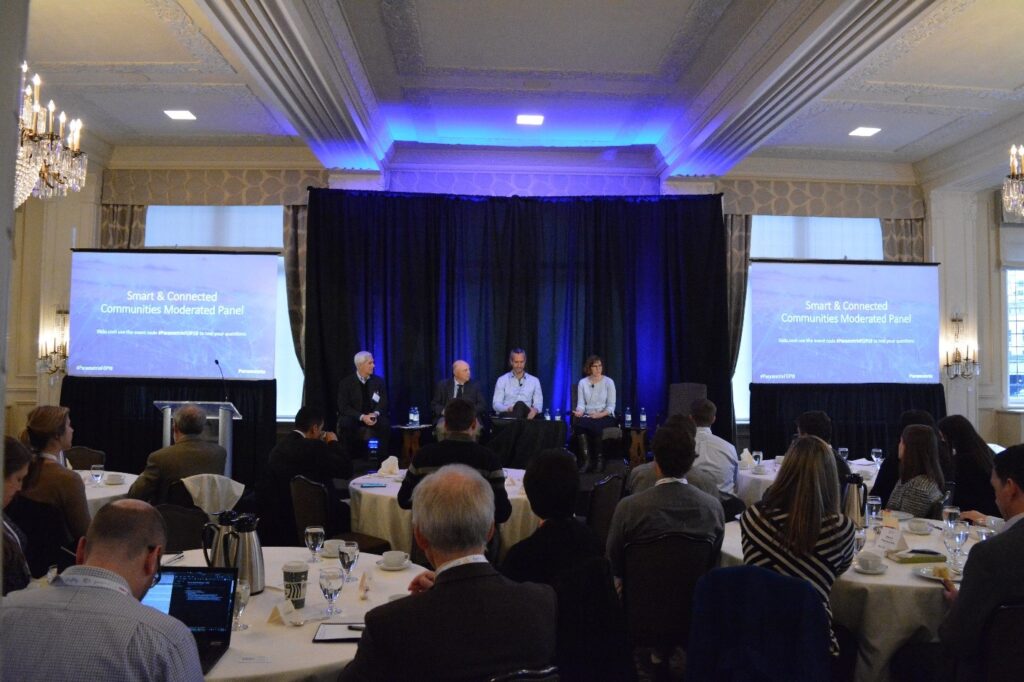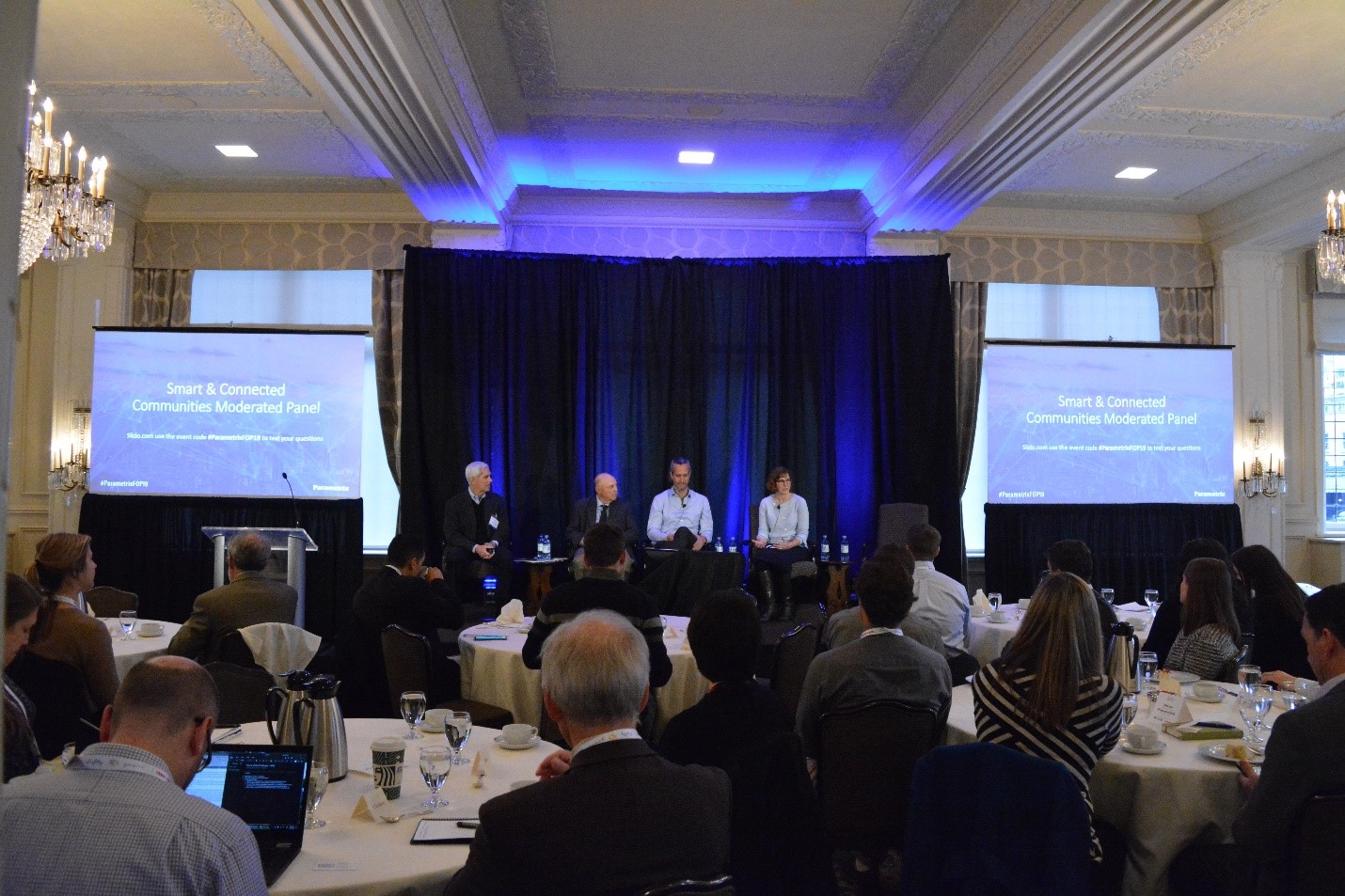
By Darby Watson
Smart and Connected Communities use the internet of things and data collection to manage assets and resources efficiently to improve people’s lives. While cities and communities rise to embrace new technologies, they must also make sure that the results are equitable and provide for a more sustainable and inclusive future.
At the Future of the Profession event, hosted by Parametrix in Seattle on November 19, 2019, we invited leaders from across the industry to discuss what smart and connected communities mean for the future of cities. Panelists included Bryan Nace of GHZ Communications, Nico Larco, AIA of University of Oregon, and Steve Marshall of City of Bellevue.

The session began with each panelist introducing their area of expertise. We then moved onto a few questions I had prepared as well as audience questions. Read a summary of the responses and watch the full video recording below.
How are public agencies addressing privacy and equity concerns associated with smart technologies?
Agencies must ensure that new technologies benefit everyone, not just the wealthy or those living in urban areas. This is an ongoing challenge that will have to be kept in mind as we see more advanced technology implemented.
Privacy is another major concern when we talk about smart communities and data collection. Private companies such as Apple and Google are able to collect data and use it to make decisions. However, public agencies haven’t been able to use data this way because of privacy concerns. Additionally, data collected by agencies is subject to public records requests. Ultimately – the way that public agencies are able to collect and use data will be up to elected officials.
There is a program being tested in Portland where replica data has been purchased that includes cell phone location, transactions, etc. This data is being used to update transportation models. While this is controversial, it allows for more data-backed and timely decisions.
What should we do when things go wrong with new technologies?
First, we must accept that there will be things that go wrong. While we can’t eliminate all risk, we must manage it and establish what can go wrong and what can’t. As technology continues to evolve, we can’t afford to stay static either. Communication with the public on what is happening is key, along with developing an internal culture of innovation (which can be very difficult, especially in the public sector).
There is a massive amount of data being collected – how do we use it efficiently?
Data from vehicles alone is coming in by the terabyte. This can be overwhelming to say the least. Using all of this data to make decisions and design better communities is the goal – but how do we get there?
Cities will need to hire people or use artificial intelligence to make sense of this mountain of data. It will need to be organized in a systematic way that backs up decision making. There are companies trying to figure out how to offer this service to the public sector.
If Transportation Network Companies (TNCs) reduce the demand for parking, why is there an insatiable demand for park and ride parking spots?
We are still seeing this demand for parking because we’re currently in an in-between zone. Some cities, such as San Francisco, have actually seen a reduction in parking attributed to TNCs. As more TNCs and autonomous vehicles are introduced we will begin to see a decrease in parking demand.
We’re also seeing a trend toward building parking that can be transformed into something later when it’s no longer needed. This can be difficult as parking garages are typically designed with low floor heights and ramps that can’t be used for other purposes later. There is a higher cost associated with building parking garages that are easy to convert later but in the long run that higher cost is worth it.
Is 5G required for autonomous vehicle use?
The short answer is no – 5G is not needed for autonomous vehicle use. While it may be helpful in some cases, it is not necessarily. Additionally, connecting AVs to 5G or any system outside of the vehicle raises hacking concerns.
Are there concerns about cyber-attacks with new technologies such as autonomous vehicles?
When autonomous vehicles are in operation, they are self-contained (like an airplane) so they can’t be hacked. There are of course concerns about data being compromised later once it’s downloaded. This is an ongoing concern just like it is for other forms of data.
Women are more likely to be harassed than men when using public transportation. Are smart cities designed for everyone?
The first step to designing cities for everyone is recognition of the problem. It’s true that transportation systems are not always designed with women in mind. As more women are involved in the decision making processes, we’ll see systems that work better for everyone.
What impact do you see drones having on smart and connected communities?
When we talk about drones there are two types – aerial drones and terrestrial drones.
Aerial drones can often be seen as a privacy violation and a nuisance. There are also safety concerns with drones in urban environments – hitting trees, wires, building, etc.
We’ve seen terrestrial drones used in food delivery services on college campuses lately. They are essentially coolers on wheels that take the place of a delivery driver. While there is opportunity for disruption (someone could come kick it over) they seem to be working so far. As more of them are deployed, the next concern is space – will they take up the sidewalk or have their own lane? There’s also the question of how cost effective they are.
The full video recording of the session can be viewed below.
Big thank you to our panelists for being a part of Parametrix’s 2019 Future of the Profession event.
Panelists

Bryan Nace | Chief Technology Officer, GHZ Communications
Bryan is the Chief Technical Officer for GHz Communications Inc., responsible for the operation of the GHz Communications’ Unified Communications test lab and technology choices to deploy. His industry experience includes strategic system planning, network design, migration, proof-of-concepts, RF communications of ITS systems, and interfaces. Bryan has been technical lead for ITS implementations in Seattle, Denver, Houston, Detroit, and Atlanta. He has authored journal articles and presented at conferences on connected vehicle networks.

Nico Larco, AIA | Director, Urbanism Next Center, University of Oregon
Nico is a Professor of Architecture and Urban Design at the University of Oregon where he is the Director of the Urbanism Next Center and Co-Director of the Sustainable Cities Institute. Urbanism Next is focused on how technological advances such as new mobility, autonomous vehicles, e-commerce, and the sharing economy are changing city form and development. He assists cities and projects with future-proofing, has run workshops and charrettes nationally and internationally on this topic, and is currently coordinating work in this area with various municipal and state agencies across North America and in Europe. Nico also researches sustainable urban design, has developed the Sustainable Urban Design Framework, and assists projects in how best to apply these principles and approaches. His work has been covered by Wired, the New York Times, Forbes, the Financial Times of London, and Newsweek. He is a Principal at Larco/Knudson, an urban design consulting firm, and a Strategic Advisor at TNO, a Dutch thinktank.

Steve Marshall | Transportation Technology Partnership Manager, City of Bellevue
Steve is leading the City of Bellevue’s advanced transportation technologies improve safety, reduce traffic congestion, cut vehicle emissions and help advance economic development. He has created partnerships with other public agencies, private sector companies, associations, think tanks and university departments. He is leading the development of several projects to accelerate and integrate new transportation technologies including a CommutePool Network that features a flexible, app based autonomous, connected, electric and shared vehicle system. Steve was formerly the executive director of the Center for Advanced Transportation and Energy Solutions (CATES), a Seattle-based think tank. He regularly writes and speaks on advanced transportation technologies and is a co‑author of “Plug-in Electric Vehicles,” published by the Brooking Institute, and of the book “Road Vehicle Automation,” on the combination of automated, connected, and electric vehicles.
About the Author

Darby Watson, AICP | Vice President, Parametrix
Darby is a strategic leader with extensive experience overseeing transportation and urban planning programs who thrives on to bringing clarity to complexity and producing optimal results. She is a collaborative, action-oriented innovator who takes pride in her ability to facilitate alignment amongst senior leaders, make data-informed decisions, and motivate teams. She uses natural talents in coaching managers to inspire positive results, adapt to change, and drive continuous learning. Darby emphasizes transparency and discovery of opportunity as part of an approachable, practical management style

